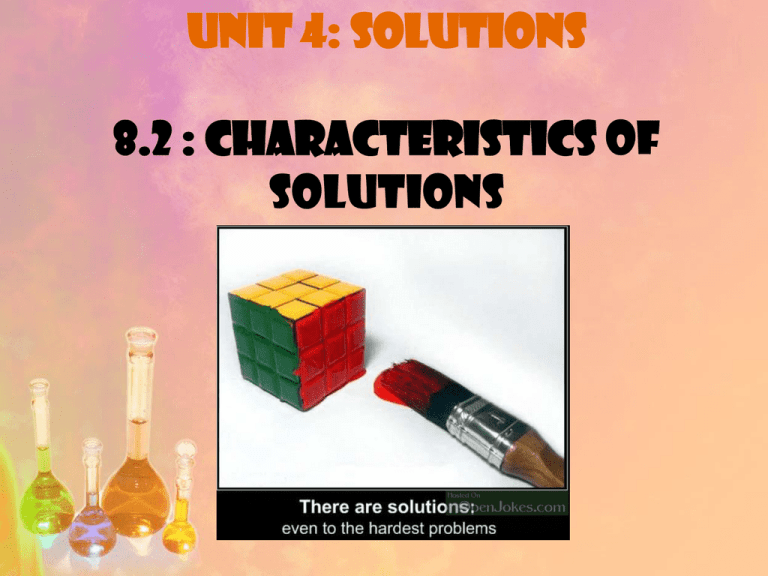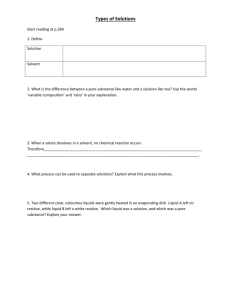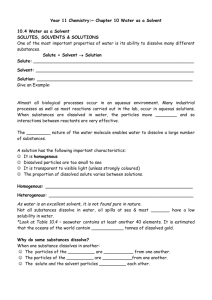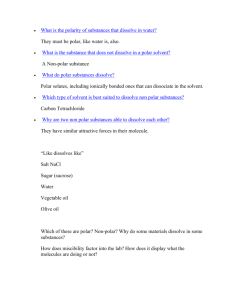Unit 4: Solutions 8.2 : Characteristics of Solutions
advertisement

Unit 4: Solutions 8.2 : Characteristics of Solutions What is a Solution? • A homogeneous mixture of two or more substances • Solutions can be • solids (ex. An alloy is a solution of two or more metals) • liquids (ex. Apple juice) • gases (ex. Air) Solution Terminology In a solution (ie: sugar water), there is: Solute the substance that is in lesser quantity the substance that dissolves in the solvent ie: sugar Solvent the substance that is in greater quantity What dissolves the solute ie: water Solution Terminology Concentrated Solution a solution with a relatively large quantity of solute compared to the volume of the solution Dilute Solution a solution with a relatively small quantity of solute compared to the volume of solution 8.3: The Dissolving Process The Dissolving of Ionic Compounds • In order for ionic compounds to dissolve, the bonds within it must be broken. • How can an ionic compound, like NaCl, dissolve in water at room temperature? By: • Hydration: the process where ions are surrounded by water molecules, and • Dissociation: the separation of ions that occurs when ionic compounds dissolve NaCl(s) Na + (aq) + Cl - (aq) 3K3PO4(s) 3 K+ (aq) + PO4 (aq) The Dissolving of Molecular Compounds • Molecular compounds vary with how easily they dissolve in water • Depends on polarity and hydrogen bonds! • Miscible liquids that mix in all proportions (ex. Ethanol and water) • Immiscible liquids that do not mix (ex. Oil and water) Dissolving Rules • RULE for dissolving: *Like Dissolves Like* • Solutes dissolve in solvents of similar polarity If solute is Ionic or polar covalent, it: • dissolves in polar solvents • because the solute-solvent attractions are strong, so the solutes are able to break the solvent HYDROGEN bonds to form new bonds. Dissolving Rules If the solute is non-polar, it: • does not dissolve in polar solvents • because the solute-solvent attractions are weak compared to the attractions between solvent molecules. Solutes cannot break solvent hydrogen bonds. Dissolving Rules Examples: • Does KCl dissolve in H2O? • YES: ionic compounds • always dissolve in water • Does CO2 dissolve in H2O? • NO: CO2 is non-polar, and water is polar. • Does CO2 dissolve in CH4? • YES: both are non-polar (like dissolves like!) Surfactant • A compound that can reduce the surface tension of a solvent • Allow polar solvents to mix with non-polar liquids (water) (oil) • Soaps and detergents are surfactants!! • When you are washing your greasy hands, does only water work to remove the grease? • NO! You need soap! Surfactant • • • • A surfactant has a non polar “tail” and a polar “head” The non-polar tail attaches to the non-polar grease or oil The polar head attaches the polar water molecules Now the water can connect to and remove the grease/oil! 8.2: pg 381 # 1 – 3, 8 8.3: pg 384 # 1; pg 389 # 2, 3, 6, 8, 12, 14




